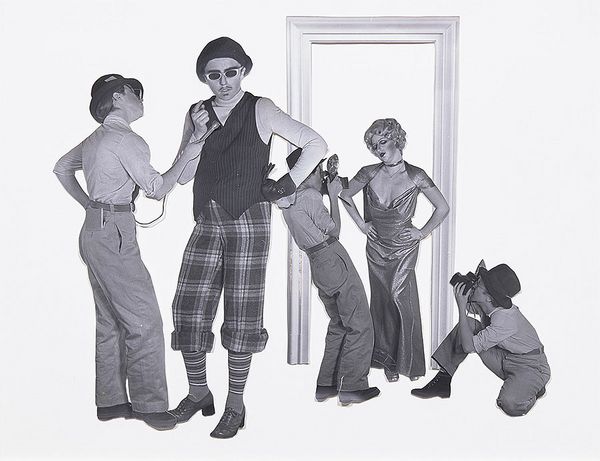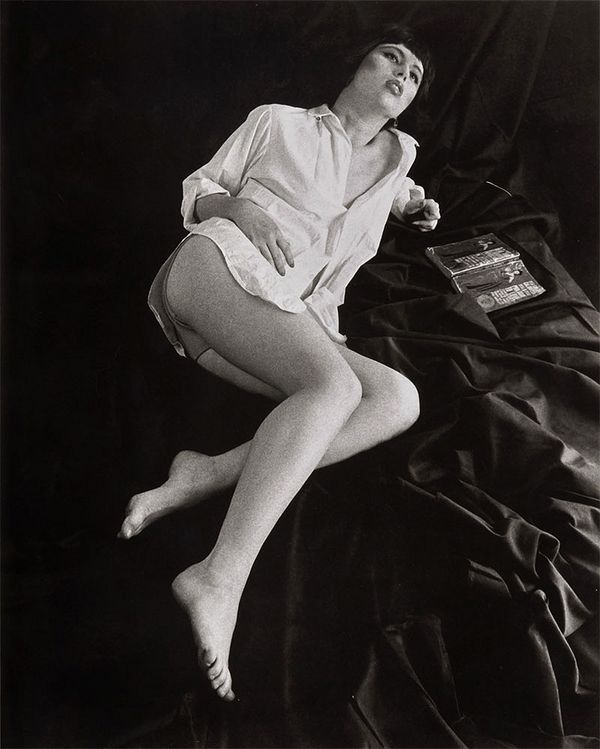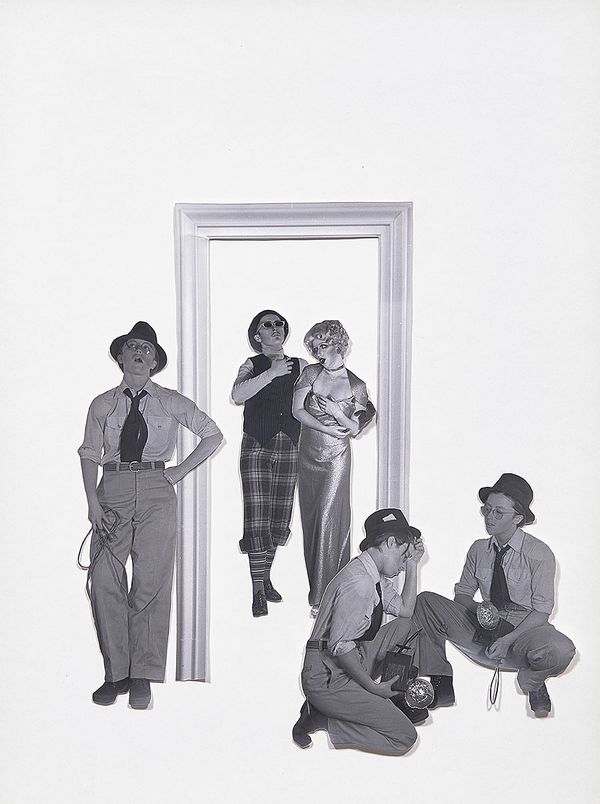Cindy Sherman, Murder Mystery, Scene 8, 1976. Photographs New York.
Phillips' 6 April Photographs New York Sale features works by Cindy Sherman that flank the artist's career, from her earliest days as a postgraduate entering the New York City art scene, to a portrait that followed her 2012 retrospective. Below, we take a look at how these works establish a throughline that sparks a conversation between her subjects across the decades.
Conceived and executed less than a year after her graduation from Buffalo State College, Cindy Sherman’s Murder Mystery contains themes that the artist would continue to explore in subsequent decades. The series, and these three images from it, are crucial touchstones in the development of Sherman’s uniquely brilliant practice. Murder Mystery is an extended pictorial narrative work consisting of 13 characters – all played by Sherman – across 80 meticulously sequenced, costumed and propped scenes, and directed by her seamless cutting and layering of images to present an unfolding drama with flashes of uncanny wit.
The mystery incorporates classic film noir structures with themes of passion, revenge, and the titular murder, surrounding the filming of an unnamed movie. The plot centers around the discovery of an illicit love affair between the Leading Man and the Actress, whose tryst reels a cast including their spouses, the movie’s Director, the Leading Man’s children, a Maid and Butler, a Detective, and various members of the Press who feature as comedic interlocution at various points in the story. Each character manifests through Sherman’s careful formation of visual cues and personality, showcasing an early example of the artist’s natural ability to transform herself.
Sherman arranged a shooting script that detailed the photographing of each character at a specific scale, depending on where they appeared within a certain frame. Post-production involved the printing of a considerable number of photographs, and then cutting out and assembling them within a given frame. When each scene was fully assembled for the exhibition, the scenes conveyed the effective illusion of three-dimensional space. Sherman also wrote detailed script notes as part of her conceptual process for each scene of Murder Mystery. The notes for the three scenes in the present lot are as follows:
Scene 8: Director (a) is consulting Actress (b) as they walk toward door. Press are waiting in front of door.
Scene 10: Press3 (a) and Director (b) are in foreground. Actress (d) assumes offbeat-obscene pose.
Scene 11: Press3 (a) & Director (b) alone. Director looks suspicious – nasty.

Cindy Sherman, Murder Mystery, Scene 10, 1976. Photographs New York.
This sequence includes the self-absorbed Director and the femme fatale Actress, as well as three members of the Press. Within the story these three images come just after the Actress has filmed a scene with the Leading Man which is cut short by the Director. In Scene 8, the director walks with a telling arm around the Actress, while the Press wait outside for their chance for an interview and photographs. In Scene 10, both Director and the Actress are accosted by the Press: the former revels in pompous chat, while the Actress poses with a sense of obligation for the cameras. Scene 11 focuses on the Press interviewing the Director, who appears not to tire of talking. We see characters with a clear narrative and several implied ones: Did the Director cut the scene out of jealousy for the Leading Man? What scandals are the Press members hounding? Sherman’s stated and implicit narrative-building is fundamental to the experience of Murder Mystery and lays a foundation for her ensuing work. Not long after Murder Mystery, Sherman would encapsulate these narrative elements into a single image with Untitled Film Stills.

Cindy Sherman, Untitled Film Still #34, 1979. Photographs New York.
Case in point: Untitled Film Still #34 continues this interest in the archetype of the temptress. With her provocative pose in a loose men's shirt against the disheveled bed linen and well-worn romance novel just to her side, Sherman offers a new contextual vision for her characters. "They were women struggling with something, but I didn't know what," she notes. "The clothes make them look a certain way, but then you look at their expression, however slight I may be, and wonder if maybe "they" are not what the clothes are communicating [...] I definitely felt that the characters were questioning something."

Cindy Sherman, Untitled #580, 2016. Photographs New York.
In 2016, Cindy Sherman debuted her first body of work since her 2012 retrospective at The Museum of Modern Art, New York. The present photograph, Untitled #580, typifies a collection of twenty portraits of past-it but no less camera-shy actresses posing for glamour shots against indulgent backdrops that can seemingly swap in as needed for their decadent outfits. Sherman never runs out of characters, so her return to the image of the seductive actress encapsulates the leitmotif of her career – that of the perception of women, especially within the focus of the camera lens, the passage of time, and how the character navigates the world in the shadow of a spotlight which is constantly looking for newer, younger faces.
If the Film Stills were centered on narrative and female archetypes, then this work is about the actresses behind those archetypes or, more accurately, the actresses no longer cast in those roles. The series is not a mockery of has-beens, however, as Betsy Berne notes in an introductory text for a book on the series. There is “no irony, no caricature here.” Instead, the image is a bold confrontation with an era, an industry, a culture that has pushed her aside and the subject, through Sherman’s eyes, is not looking away. Her era in the spotlight is long gone but her spirit and confidence remain, and it is those attributes that Sherman captures so masterfully.
Look again at the Actress in Scene 10 of Murder Mystery, how she poses uncomfortably, averting her gaze despite the gawking press and inviting lens, as if to imply that she is merely filling out a dress, that anyone would do in that situation so long as the paparazzi have someone to build a narrative around. Compare that to the assured gaze of the subject in Untitled #580. If the lens won’t look for her, she won’t look for it either, and is all the more powerful in doing so. Perhaps 40 years on, the Actress from Murder Mystery might have sat for the series, but despite the thousands of outfit changes that may have occured between the two images, the takeaway remains: There is is only one Cindy Sherman, no matter who she is.
Discover More from Photographs New York >
Recommended Reading
A Mapping of the Self: Photographs from the Collection of Peter McLeavey >
